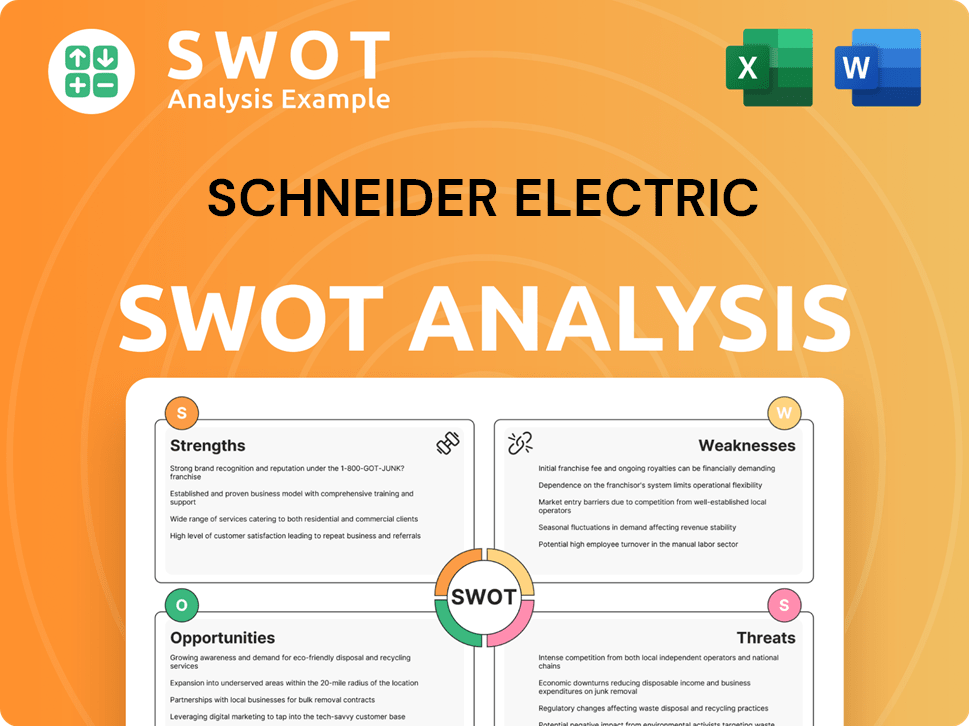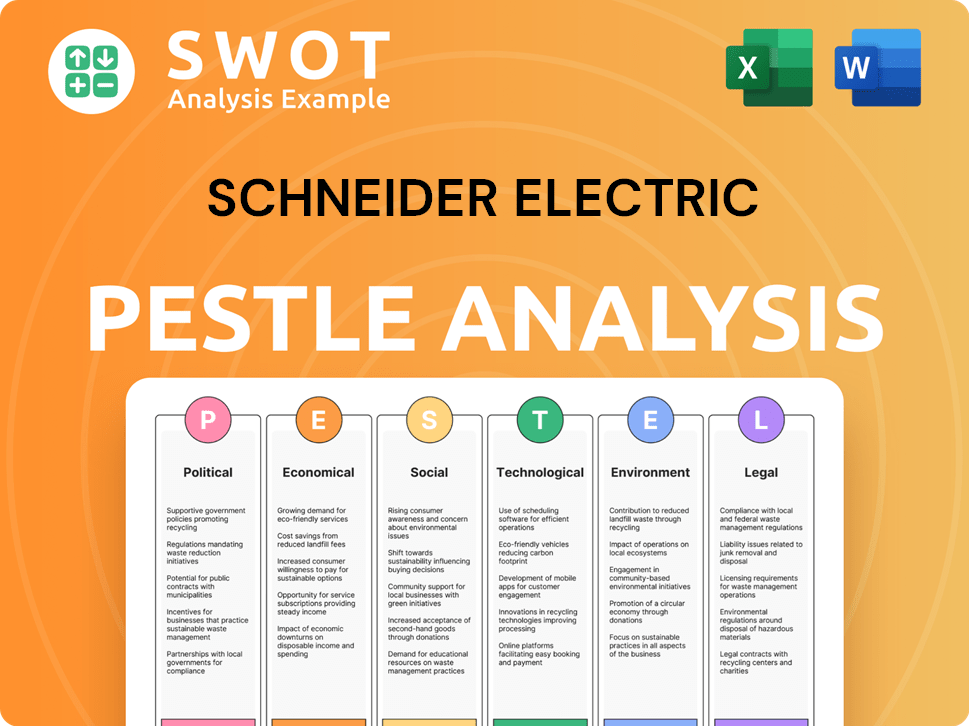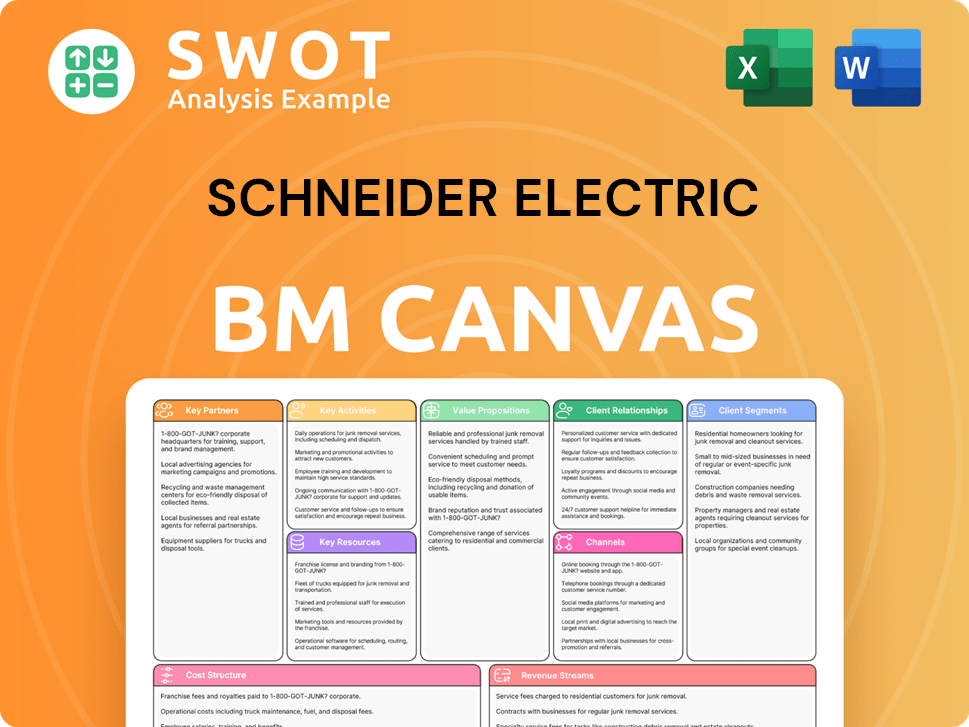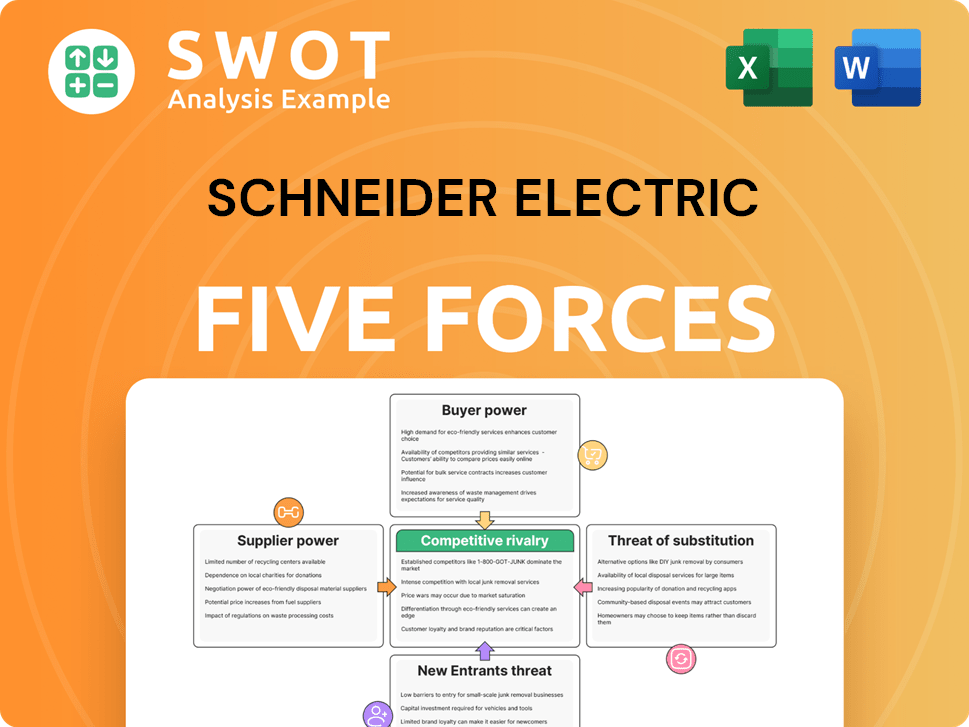Schneider Electric Bundle
How Does Schneider Electric Dominate the Energy Management Sector?
In an era defined by the urgent need for sustainable solutions, understanding the competitive landscape of industry leaders like Schneider Electric is crucial. The company's strategic focus on AI and sustainable energy transitions has significantly shaped its market position. This analysis delves into Schneider Electric's competitive environment, exploring its rivals and the strategies underpinning its continued growth.

To truly grasp Schneider Electric's standing, we must examine its Schneider Electric SWOT Analysis, key players, and market share dynamics. This comprehensive analysis will dissect Schneider Electric's competitive advantages, challenges, and opportunities within the industry. Furthermore, we'll compare Schneider Electric's financial performance against its competitors, providing a detailed market analysis report and insight into its global market presence and business strategy.
Where Does Schneider Electric’ Stand in the Current Market?
Schneider Electric holds a robust market position within the digital automation and energy management sector. The company is recognized as a leading player in key areas like building management systems, industrial automation, and critical power solutions. Its substantial scale and financial health are evident, with reported revenue of approximately €36 billion in 2023, reflecting its strong market presence.
The company's primary offerings include EcoStruxure, its IoT-enabled architecture, along with uninterruptible power supplies (UPS), electrical distribution equipment, and building automation solutions. Serving customers across over 100 countries, its geographic footprint is extensive, with significant presence in Europe, North America, and Asia-Pacific. Schneider Electric caters to diverse customer segments, from residential and commercial buildings to large industrial enterprises and data centers.
Over time, Schneider Electric has strategically shifted its positioning, embracing digital transformation to offer more integrated, software-defined solutions. This move goes beyond traditional hardware sales, providing comprehensive, end-to-end energy management and automation platforms. This includes a notable emphasis on sustainability-driven offerings, aligning with global environmental goals. The company's strong financial performance and strategic investments in R&D underscore its robust market standing, though it faces varying degrees of competition across different regions and specialized product niches.
Schneider Electric consistently ranks among the top competitors in several key segments within the energy management and automation industry. While specific market share figures vary by product and region, the company is often cited as a leader in building management systems, industrial automation, and critical power solutions. This strong market position is supported by its extensive product portfolio and global presence.
The company's core offerings include a broad range of products and services. These include EcoStruxure (an IoT-enabled architecture), uninterruptible power supplies (UPS), electrical distribution equipment, industrial control systems, and building automation solutions. These diverse offerings cater to various customer needs across multiple sectors, reinforcing its market position.
Schneider Electric has a significant global presence, serving customers in over 100 countries. Its strongholds are in Europe, North America, and Asia-Pacific. The company serves diverse customer segments, including residential and commercial buildings, large industrial enterprises, and data centers. This broad reach supports its strong competitive standing.
Schneider Electric has strategically embraced digital transformation. This shift involves offering more integrated, software-defined solutions, moving beyond traditional hardware sales. The company focuses on providing comprehensive, end-to-end energy management and automation platforms. This strategic pivot enhances its competitive advantage.
Schneider Electric's strong financial performance and consistent investments in research and development (R&D) underscore its robust market standing. The company's financial health enables it to innovate and expand its offerings. This financial strength allows it to maintain and enhance its competitive position within the industry.
- Revenue in 2023 reached approximately €36 billion.
- The company's investments in R&D drive innovation and product development.
- Strategic acquisitions and partnerships further strengthen its market position.
- Focus on sustainability-driven solutions aligns with global trends.
Schneider Electric SWOT Analysis
- Complete SWOT Breakdown
- Fully Customizable
- Editable in Excel & Word
- Professional Formatting
- Investor-Ready Format

Who Are the Main Competitors Challenging Schneider Electric?
The Schneider Electric competitive landscape is characterized by intense rivalry across various business segments. Understanding the key players and their strategies is crucial for assessing the company's position in the market. This analysis provides insights into the main competitors, their strengths, and how they challenge Schneider Electric's market share.
The company faces competition from both direct and indirect rivals, each vying for market dominance in areas like industrial automation, energy management, and building technologies. Analyzing these competitive dynamics is essential for investors and strategists alike. For a deeper dive into the company's growth trajectory, consider exploring the Growth Strategy of Schneider Electric.
Schneider Electric's primary competitors include Siemens AG, ABB Ltd., and Eaton Corporation, each with significant market presence and diverse product offerings. These companies compete directly in several core markets, making the competitive environment dynamic and challenging.
Siemens is a major competitor, particularly in industrial automation and smart infrastructure. The company's broad portfolio allows it to compete across multiple segments, posing a significant challenge to Schneider Electric. In 2024, Siemens reported revenues of approximately €77.8 billion, demonstrating its substantial scale and market influence.
ABB is a key rival, especially in robotics, power grids, and electrification products. ABB's focus on these areas makes it a direct competitor in several of Schneider Electric's key markets. ABB's revenue in 2024 was around $32.2 billion, reflecting its strong position in the global market.
Eaton Corporation competes strongly in electrical products, systems, and services. Eaton's focus on power management solutions makes it a direct competitor in critical areas. Eaton's revenue in 2024 was approximately $23.2 billion, highlighting its significant market share.
Vertiv specializes in data center solutions and competes with Schneider Electric in the critical power and cooling market. Vertiv's focus on data center infrastructure makes it a specialized competitor. Vertiv's revenue in 2024 reached approximately $6.8 billion.
Honeywell is a significant competitor in building management systems. Honeywell's expertise in building automation makes it a direct rival in this segment. Honeywell's revenue in 2024 was around $36.6 billion.
Johnson Controls competes in building management systems and offers solutions for critical power and cooling. Johnson Controls' focus on building technologies makes it a direct competitor. Johnson Controls' revenue in 2024 was about $26.8 billion.
The Schneider Electric competitive landscape is also influenced by indirect players and emerging companies. These companies often focus on specific niches, such as renewable energy management or AI-driven predictive maintenance. The competitive dynamics are continually reshaped by mergers, acquisitions, and strategic alliances, requiring Schneider Electric to remain innovative and agile. The company must continually adapt its business strategy to maintain its position among the key players and address the challenges and opportunities presented by the evolving market.
Several factors drive competition within the Schneider Electric industry analysis, including technological innovation, market share, and geographical presence. Understanding these factors is crucial for assessing the company's competitive advantages.
- Technological Innovation: Continuous advancements in automation, energy management, and digital solutions are critical.
- Market Share and Global Presence: The ability to compete in diverse global markets is a key factor.
- Product Portfolio: A comprehensive product range across different segments is essential.
- Sustainability Initiatives: Growing emphasis on sustainable solutions and green technologies.
- Customer Relationships: Strong customer relationships and service capabilities are crucial.
Schneider Electric PESTLE Analysis
- Covers All 6 PESTLE Categories
- No Research Needed – Save Hours of Work
- Built by Experts, Trusted by Consultants
- Instant Download, Ready to Use
- 100% Editable, Fully Customizable

What Gives Schneider Electric a Competitive Edge Over Its Rivals?
Understanding the competitive landscape of Schneider Electric requires a deep dive into its strengths and strategic positioning. The company, a key player in energy management and automation, has cultivated several competitive advantages over the years. These advantages are critical in assessing its market position and future prospects. Recent market analyses highlight the ongoing evolution of the industry, with sustainability and digital transformation driving significant changes.
Schneider Electric's success is not just about its products; it's about its integrated approach to energy management and automation. The company's ability to offer comprehensive solutions, from hardware to software and services, sets it apart. This approach is particularly relevant in today's market, where customers seek holistic and efficient solutions. Furthermore, its global presence and brand reputation contribute significantly to its competitive edge.
The following sections will delve into Schneider Electric's key competitive advantages, including its technological prowess, brand equity, global reach, and commitment to sustainability. We will also examine how these advantages contribute to its market share and overall financial performance. This analysis is essential for anyone looking to understand the dynamics of the energy management and automation industry.
Schneider Electric's competitive advantages are significantly bolstered by its technological innovation, particularly its EcoStruxure platform. EcoStruxure is an IoT-enabled architecture that provides integrated solutions for power, building, machine, and plant automation. This platform enhances safety, reliability, efficiency, sustainability, and connectivity. The company's continuous investment in R&D, including AI and IoT, ensures it remains at the forefront of innovation.
The company benefits from strong brand equity and a vast global distribution network. The brand is synonymous with quality and reliability in the energy management and automation sectors. Its expansive sales and service network spans over 100 countries, ensuring widespread market reach and effective customer support. This global presence is a significant advantage in the competitive landscape.
Schneider Electric's commitment to sustainability and strong ESG performance is a key differentiator. This resonates with environmentally conscious customers and investors. The company's focus on sustainability initiatives provides a reputational advantage and aligns with the growing demand for green solutions. This focus helps to drive long-term value.
Economies of scale, derived from its large operational footprint and high production volumes, enable cost efficiencies. These efficiencies can be passed on to customers or reinvested into research and development. This operational efficiency contributes to the company's profitability and competitive pricing. The company's ability to manage its supply chain effectively is also a key factor.
Schneider Electric's competitive advantages are multifaceted, including technological innovation, brand equity, global reach, sustainability efforts, and operational efficiency. These advantages enable the company to maintain a strong position in the market and drive growth. The company's focus on innovation and customer satisfaction further strengthens its market position. For more insights into the company's financial health, consider the information provided by Owners & Shareholders of Schneider Electric.
- EcoStruxure architecture and technological leadership.
- Strong brand recognition and global distribution network.
- Commitment to sustainability and ESG performance.
- Operational efficiency and economies of scale.
Schneider Electric Business Model Canvas
- Complete 9-Block Business Model Canvas
- Effortlessly Communicate Your Business Strategy
- Investor-Ready BMC Format
- 100% Editable and Customizable
- Clear and Structured Layout

What Industry Trends Are Reshaping Schneider Electric’s Competitive Landscape?
The competitive landscape for Schneider Electric is undergoing significant shifts, driven by digital transformation, the push for decarbonization, and the rise of AI and IoT. These trends present both challenges and opportunities for the company. Understanding the Schneider Electric competitive landscape and its position within the industry is crucial for assessing its future prospects.
Schneider Electric's market share and competitive standing are influenced by factors such as technological innovation, strategic partnerships, and the ability to adapt to evolving market demands. The company faces intense competition, requiring continuous efforts in R&D and market expansion to maintain its position. An in-depth Schneider Electric industry analysis reveals the complexities of its operating environment.
Digital transformation, decarbonization efforts, and the integration of AI and IoT are key trends. These trends are driving demand for energy-efficient solutions and smart technologies. The focus on sustainability and efficiency is reshaping the competitive dynamics within the industry.
Challenges include intense price competition, the risk of technological obsolescence, and geopolitical instabilities. New business models like Energy-as-a-Service (EaaS) and regulatory scrutiny add complexity. Adapting to these challenges is essential for long-term success.
Opportunities lie in emerging markets, smart grid solutions, and sustainable data center technologies. Expansion into these areas and strategic partnerships are key. Innovation and R&D efforts are crucial for capitalizing on growth opportunities.
Schneider Electric is investing in R&D and forming strategic partnerships. Focusing on next-generation solutions and expanding into high-growth markets is a priority. These strategies aim to strengthen its competitive position and ensure long-term resilience.
Key factors include technological innovation, market presence, and financial performance. Schneider Electric's competitive advantages are enhanced by its global market presence and product portfolio. Understanding these factors is essential for a detailed Schneider Electric market analysis report.
- Technological Leadership: Continuous innovation in energy management and automation.
- Market Reach: Extensive global presence, particularly in emerging markets.
- Strategic Partnerships: Collaborations to enhance product offerings and market access.
- Sustainability Initiatives: Commitment to reducing carbon emissions and promoting energy efficiency.
The competitive environment involves various Schneider Electric competitors, including Siemens, ABB, and Eaton. A detailed Schneider Electric vs Siemens comparison reveals specific strengths and weaknesses. The company's ability to adapt to changing market dynamics and its focus on sustainability are critical for future success. For more insights into the company's business model, consider reading about the Revenue Streams & Business Model of Schneider Electric.
Schneider Electric Porter's Five Forces Analysis
- Covers All 5 Competitive Forces in Detail
- Structured for Consultants, Students, and Founders
- 100% Editable in Microsoft Word & Excel
- Instant Digital Download – Use Immediately
- Compatible with Mac & PC – Fully Unlocked

Related Blogs
- What are Mission Vision & Core Values of Schneider Electric Company?
- What is Growth Strategy and Future Prospects of Schneider Electric Company?
- How Does Schneider Electric Company Work?
- What is Sales and Marketing Strategy of Schneider Electric Company?
- What is Brief History of Schneider Electric Company?
- Who Owns Schneider Electric Company?
- What is Customer Demographics and Target Market of Schneider Electric Company?
Disclaimer
All information, articles, and product details provided on this website are for general informational and educational purposes only. We do not claim any ownership over, nor do we intend to infringe upon, any trademarks, copyrights, logos, brand names, or other intellectual property mentioned or depicted on this site. Such intellectual property remains the property of its respective owners, and any references here are made solely for identification or informational purposes, without implying any affiliation, endorsement, or partnership.
We make no representations or warranties, express or implied, regarding the accuracy, completeness, or suitability of any content or products presented. Nothing on this website should be construed as legal, tax, investment, financial, medical, or other professional advice. In addition, no part of this site—including articles or product references—constitutes a solicitation, recommendation, endorsement, advertisement, or offer to buy or sell any securities, franchises, or other financial instruments, particularly in jurisdictions where such activity would be unlawful.
All content is of a general nature and may not address the specific circumstances of any individual or entity. It is not a substitute for professional advice or services. Any actions you take based on the information provided here are strictly at your own risk. You accept full responsibility for any decisions or outcomes arising from your use of this website and agree to release us from any liability in connection with your use of, or reliance upon, the content or products found herein.